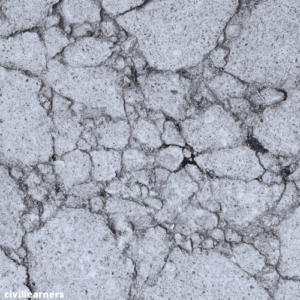MICRO-CRACKING OF CONCRETE
Micro-cracking of concrete refers to the separation of individual components, resulting in a discontinuous material as depicted in Fig. 8.29.
Depending upon the extent of cracking the cracks can be classified as macro-cracks, micro-cracks, and semi-micro-cracks. According to the location, the cracks can be classified as bond cracks, mortar cracks, and aggregate cracks.
At the interface of the aggregate and mortar, bond cracks form, whereas mortar cracks and aggregate cracks occur through the mortar and aggregate, respectively

Knowledge of the micro-cracking of concrete contributes considerably to understanding its properties, such as its inelastic nature, the descending portion of the stress−strain curve, the strength under combined, repeated, and sustained loading, etc.
The stress−strain curve is related to internal cracking. The nonlinearity of the stress−strain relation is due to the propagation of bond and mortar cracks.
Measuring lateral expansion/contraction, surface cracking, and sonic methods indirectly determine the progressive cracking and increasing strain in concrete.
The exact nature of the cracks and the deformations to which they occur provide accurate information pertinent to the mechanism of cracking. Direct microscopic observations help to study the extent of cracking both quantitatively and qualitatively.
You may also like: Repair cracks in concrete
The bond between the aggregate and the mortar plays an important role in controlling the strength characteristics of concrete.
The existence of adhesion cracks before loading constitutes one of the weakest links in the heterogeneous concrete system. Due to the settling of fresh concrete, hydration of cement, and shrinkage of concrete, bond cracks exist in hardened concrete near large aggregates.
Researchers have found that the bonding force between the aggregate and the mortar is lower than the tensile strength of the mortar.
The bond between aggregate and mortar controls concrete failure under uniaxial tensile load, while mortar’s tensile strength controls compressive strength.
The failure process in plain concrete is continuous and proceeds in two ways. Joint cracks alone cannot cause failure as they are isolated from each other. Failure occurs only when there are enough joint cracks interconnected with mortar cracks.
The development of a continuous crack pattern does not immediately lead to loss of bearing capacity as the concrete remains highly redundant.
You may also like: Ultra-lightweight concrete
As bond cracking occurs, alternative loading routes emerge either through mortar or a combination of mortar and aggregate.
With a decrease in the number of load paths, stress intensity, and strain magnitude on remaining paths increase rapidly.
When an extensive and continuous crack pattern forms and load paths are significantly reduced, concrete’s load-bearing capacity decreases.
At this stage, the stress-strain curve begins to descend, indicating a decline in the concrete’s capacity to bear additional load.

